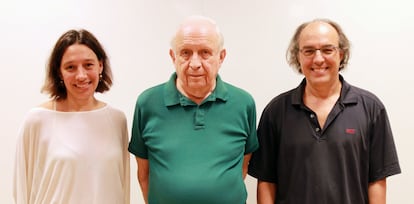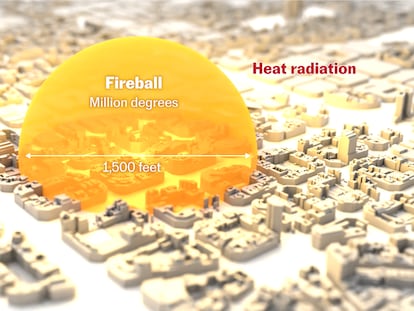The Manhattan Project’s last survivor
A new book and documentary film about Nobel laureate Roy J. Glauber offer a fascinating look into the early days of the Los Alamos National Laboratory


In the early 1940s, Los Alamos, New Mexico was a peaceful US town inhabited by young couples, plenty of children, and workers with enough leisure time to enjoy the good weather and desert environment. After work, you could go for a walk, watch a movie for 10 cents, attend a lecture or go to a dance. Due to military regulations, only low-proof alcoholic beverages were available, but many scientists used their know-how to brew their own libations. The bucolic scenes of Los Alamos life belied the fact that these young families were building some of the most horrific and destructive weapons ever known, and which still threaten humanity today.
The main storyline of the first atomic bomb is well known. In 1938, German scientists Lise Meitner and Otto Hahn discovered how to release large quantities of energy through nuclear fission, as Albert Einstein had theorized in the famous scientific equation: E=mc². Physicist Leo Szilard saw the military applications of nuclear fission and convinced Einstein to sign a letter to President Franklin D. Roosevelt urging him to beat the Nazis in developing a nuclear weapon. Roosevelt then established the ambitious Manhattan Project in the Los Alamos National Laboratory, which would ultimately produce “Little Boy” and “Fat Man,” the atomic bombs that devastated Hiroshima and Nagasaki in 1945, ended World War II and changed the course of human history. Ever since then, civilization has had the capacity to easily annihilate itself.
Told through the eyes of American physicist Roy J. Glauber, a new book and documentary film gives audiences a look into the early days of Los Alamos National Laboratory. Glauber was the youngest of the Manhattan Project’s theoretical scientists, and went on to win the 2005 Nobel Prize in Physics for his pioneering work in the field of quantum optics. His memories of his Manhattan Project experiences have been recorded in a recent book titled La Última Voz (The Last Voice, in English) and in That’s the Story, a documentary film available on YouTube. Communications expert and university professor María Teresa Soto-Sanfiel, and physics professor José Ignacio Latorre collaborated to produce the book and the film.
It all started over drinks. “We were at a conference in Benasque [northern Spain] and I took Glauber out for drinks – he had never tasted a mojito – because you have to treat Nobel laureates well,” jokes Latorre. Loosened up by the cocktail, Glauber began to tell anecdotes about some 20th-century luminaries in the field of physics. How did he know all those people? “I worked on the Manhattan Project when I was 18 years old,” said Glauber, one of the few project members still living at the time. After that initial mojito-tasting session and several other chance encounters, Glauber decided to collaborate with the authors in recording the material for the book and film. Coincidentally, the Manhattan Project archives were declassified just as they started to collect material for the documentary. They obtained 17 hours of footage from those archives, much of which had never been seen by the public. “Glauber was very meticulous and detailed in our interviews, which gave us a very vivid picture of those times,” said Soto-Sanfiel. “It was a picture of life in Los Alamos told by one of its protagonists, which is quite unusual.”

Glauber occasionally describes Los Alamos as a utopian but spartan home for those that lived and worked there. It was a lost world, inexpensive but with not much to do besides work. “But the young Glauber marveled at many aspects of life at Los Alamos,” said Latorre. “Apparently the food was very good (Glauber was still a big eater at age 90), the weather was good, and he was surrounded by some of the sharpest minds in the world.”
The intellectual horsepower dazzled young Glauber, who had not yet finished his studies at Harvard University when he was assigned to the project. There was Robert Oppenheimer, the project’s scientific director, who had a great talent for understanding and communicating complex physics concepts to people like General Leslie Groves, the overall project director.
Glauber describes Oppenheimer as a romantic and connoisseur of classical Hindu writings (he was fluent in Sanskrit), a sharp contrast to the typical pragmatism of American scientists. When Oppenheimer observed the first atomic bomb test in the New Mexico desert, he quoted the Bhagavad Gita: “Now I am become Death, the destroyer of worlds.” Oppenheimer, a film directed by Christopher Nolan, will be released in 2023.
Glauber describes Hans Bethe, who was responsible for the theoretical aspects of the project, as a highly intelligent man and collaborative coworker. Enrico Fermi was ingenious at complex calculations and models, and Richard Feynman had a talent for viewing physics problems in entirely new ways. Feynman was often the center of attention with his bottomless well of stories and anecdotes, as evidenced by his well-known biography, Surely You’re Joking, Mr. Feynman!, which has inspired generations of students around the world. Glauber had some reservations about Feynman, whom he faulted for deliberately outlandish behavior. “Glauber was a quiet and serious man, while Feynman was just the opposite, someone who liked the limelight,” said Soto-Sanfiel, “so Glauber considered Feynman a bit frivolous, although he had great intellectual respect for him.”
Glauber was an eyewitness to the first explosion of an atomic bomb in July 1945 – the Trinity test – which was detonated in the New Mexico desert. Because he worked on the project as theoretical physicist, he and some of his colleagues weren’t invited to the test. Nevertheless, they traveled 70 miles (112 kilometers) to a mountaintop near Albuquerque, New Mexico’s largest city. When the 20-kiloton bomb exploded, they were terrified by the nuclear mushroom that rose into the night sky. At the detonation site, the sand had melted into a bright green, jade-like glassy residue, later named trinitite. Glauber described the first test of an atomic bomb as “massive and sinister.” For the next month after the test, no one in the lab wanted to talk about what they had witnessed.
The story told in the book and documentary doesn’t end at in Los Alamos, but goes on to describe Oppenheimer’s fall from grace, a victim of the witch-hunt orchestrated by physicist Edward Teller, who accused him of being a communist. Teller had become increasingly influential due to his leadership role in nuclear weapons development, particularly the hydrogen bomb.
Glauber died in December 2018 while the book was still being edited. He wasn’t alive to see the invasion of Ukraine, with its nuclear saber-rattling reminiscent of the Cold War. “Back then [during the Cold War], there was almost no talk of nuclear threats and, as we found when previewed an early version of the documentary, most people thought that the specter of total annihilation contributed to a long period of peace in Europe,” said Latorre.
Glauber never regretted participating in the Manhattan Project because he had a relatively unimportant role and because thousands of young soldiers were dying “like flies” while the Nazis raced to build their own bomb. “Of course,” Soto-Sanfiel said, “when the bombs were dropped on Japan, Glauber left the Manhattan Project and never wanted to hear anything more about the nuclear arms race.”
Tu suscripción se está usando en otro dispositivo
¿Quieres añadir otro usuario a tu suscripción?
Si continúas leyendo en este dispositivo, no se podrá leer en el otro.
FlechaTu suscripción se está usando en otro dispositivo y solo puedes acceder a EL PAÍS desde un dispositivo a la vez.
Si quieres compartir tu cuenta, cambia tu suscripción a la modalidad Premium, así podrás añadir otro usuario. Cada uno accederá con su propia cuenta de email, lo que os permitirá personalizar vuestra experiencia en EL PAÍS.
¿Tienes una suscripción de empresa? Accede aquí para contratar más cuentas.
En el caso de no saber quién está usando tu cuenta, te recomendamos cambiar tu contraseña aquí.
Si decides continuar compartiendo tu cuenta, este mensaje se mostrará en tu dispositivo y en el de la otra persona que está usando tu cuenta de forma indefinida, afectando a tu experiencia de lectura. Puedes consultar aquí los términos y condiciones de la suscripción digital.










































